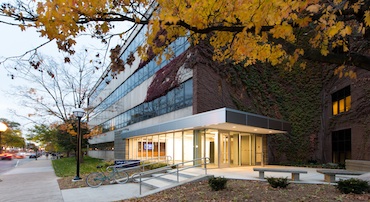Findings Offer New Ideas About Vaccine Development

This news item was originally released by the University of Michigan News Service.
Vaccine development is largely trial and error—which results in years of pricey development and just a 6 percent success rate—but a University of Michigan researcher believes he's found a way to potentially improve those numbers.
Wei Cheng, a U-M associate professor of pharmacy, and his research lab have identified a common molecular feature in existing viral vaccines that if applied broadly at the outset of new development, Cheng believes might shave years off vaccine production time while improving their success rate.
"A major hurdle in vaccine development is the lack of general principles that can be applied in the strategic decision and the formulation of a vaccine," he said. "The development of a successful vaccine remains largely empirical in nature. Even though the vaccines are available, in many cases, the molecular basis that underlines the successful immune response is not clear."
The Cheng lab attempted to remove some of that guesswork by comparing the molecular features of more than a dozen successful licensed viral vaccines. In doing so, they discovered a commonality among them: All feature a relatively high density of viral proteins on the surface of the vaccine carrier.
Think of the vaccine carrier as the bus, and the protein density on the surface as the number of billboards on the sides of the bus, Cheng said. The more billboards there are, the better and more effective the vaccine could be. An optimized protein density is the key to successful immune response.
Cheng believes if vaccine development were standardized so that new vaccines were formulated with an eye toward optimizing the density of surface proteins on the carrier, it could shorten vaccine development time and improve their success.
"This perspective may provide a clear route for the development and formulation of antibody-based vaccines with higher probability of success," he said. "For a new vaccine, the probability of success is only 6 percent. It's very important to have something that can be used as a principal to guide this strategic decisions and also the formulation."
In the short term, Cheng believes that retroactive studies can be implemented on vaccines currently in clinical or preclinical trials in order to take his findings into account.
Cheng's theory about the potential linkage between protein density and vaccines has been fermenting since 2011, he said. The group published a paper in 2014 outlining a new optical technique they'd developed that permitted them to quantify the protein density on HIV particles, and found that different quantities of a key protein enabled virulence in HIV, and the protein-rich HIV particles were more infectious than the others.
The success of the 2014 Ebola outbreak vaccine was a good test of Cheng's theory.
Electron microscopy images of the Ebola virus revealed a very high surface protein density—the same feature that Cheng's lab found in successful vaccines—and about half of all Ebola patients survived and healed.
The Ebola vaccine that was developed also had a very high surface protein density, Cheng said, and that vaccine was deemed 100 percent effective.
"The Ebola outbreak was a good test of my theory," he said. "I was indeed very excited when I saw the patient outcomes reported for Ebola, which is consistent with my theory."
The study, "The density code for the development of a vaccine?" ran in the Journal of Pharmaceutical Sciences in November 2016, and was selected by editors for inclusion in the issue featuring the "Most Original and Most significant" findings of the quarter.



